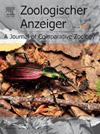A comparative morphological analysis of three mud crabs species (Scylla spp.) across two oceanic regions along the coastal waters of Thailand
IF 1.5
3区 生物学
Q2 ZOOLOGY
引用次数: 0
Abstract
This study aimed to investigate morphological variation within and between three Scylla species: Scylla olivacea, Scylla paramamosain, and Scylla tranquebarica. A total of 1175 mud crab specimens were collected from two distinct oceanic regions: the Gulf of Thailand (Pacific Ocean) and the Andaman Sea (Indian Ocean). A comprehensive suite of 22 morphometric characters was meticulously measured on each individual using a digital vernier caliper to a precision of 0.01 mm. Canonical Discriminant Function Analysis (CDFA) was employed to explore patterns of phenotypic divergence across species and geographic regions. Additionally, Principal Component Analysis (PCA) and CDFA were utilized to assess intraspecific sexual dimorphism within each species. The findings of this study confirmed significant phenotypic variation among both male and female individuals of all three Scylla species. Furthermore, pronounced intraspecific sexual dimorphism was observed, with distinct morphological differences evident in 16 characters for S. olivacea, 14 for S. paramamosain, and 9 for S. tranquebarica. Moreover, populations of S. olivacea and S. paramamosain from the Pacific and Indian Oceans exhibited significant morphological differentiation. These results provide crucial insights into the morphological diversity of these economically important species and offer a valuable scientific foundation for future research and conservation efforts.
泰国沿海两洋区三种泥蟹的比较形态学分析
本研究旨在探讨三种Scylla: Scylla olivacea、Scylla paramamosain和Scylla tranquebarica的形态变异。从两个不同的海洋区域:泰国湾(太平洋)和安达曼海(印度洋)共收集了1175只泥蟹标本。使用数字游标卡尺对每个个体的22个形态特征进行了精确测量,精度为0.01毫米。采用典型判别函数分析(CDFA)探讨了不同物种和地理区域间的表型差异模式。此外,利用主成分分析(PCA)和CDFA来评估每个物种的种内两性二态性。本研究结果证实了三种Scylla的雄性和雌性个体之间存在显著的表型差异。此外,还观察到明显的种内两性二态性,其中橄榄葡萄有16个性状,paramamosain有14个性状,tranquebarica有9个性状存在明显的形态差异。此外,来自太平洋和印度洋的S. olivacea和S. paramamosain种群表现出明显的形态分化。这些结果为了解这些具有重要经济价值的物种的形态多样性提供了重要的见解,并为未来的研究和保护工作提供了宝贵的科学基础。
本文章由计算机程序翻译,如有差异,请以英文原文为准。
求助全文
约1分钟内获得全文
求助全文
来源期刊

Zoologischer Anzeiger
生物-动物学
CiteScore
2.80
自引率
7.10%
发文量
75
审稿时长
>12 weeks
期刊介绍:
Zoologischer Anzeiger - A Journal of Comparative Zoology is devoted to comparative zoology with a special emphasis on morphology, systematics, biogeography, and evolutionary biology targeting all metazoans, both modern and extinct. We also consider taxonomic submissions addressing a broader systematic and/or evolutionary context. The overall aim of the journal is to contribute to our understanding of the organismic world from an evolutionary perspective.
The journal Zoologischer Anzeiger invites suggestions for special issues. Interested parties may contact one of the editors.
 求助内容:
求助内容: 应助结果提醒方式:
应助结果提醒方式:


